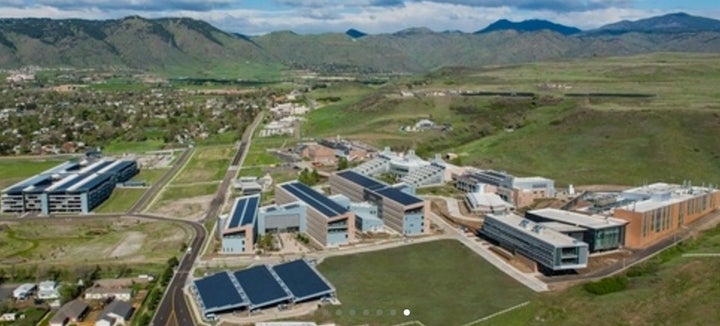
President Trump has proposed a major budget cut for the National Renewable Energy Laboratory in Colorado. But the Lab could help him reenter the Paris climate accord.
The Associated Press reports that French President Emmanuel Macron has been reminiscing about his meetings with Donald Trump, including their conversation about the Paris climate accord. Macron hopes his “glamorous Paris charm offensive” changed the U.S. president's mind about climate change.
Probably not. In a joint news event with Macron, Trump responded weakly, “If (rejoining the accord) happens, that will be wonderful, and if it doesn’t that will be OK too.” Perhaps he did the charming and convinced Macron that there is still a chance the United States will come back to the table.
Those who are familiar with Trump’s style have seen this kind of “maybe, maybe not” position before. The President likes to leave us guessing with statements that create an expectation he doesn’t intend to fulfill. Another recent example was his hint in June that there might be tape recordings of his conversations with former FBI Director James Comey. Trump left the press and the country in suspense for two weeks before he admitted that no such tapes exist.
Let’s play along, however, and assume that Trump really is open to reentering the Paris accord if the U.S. commitment is to his liking. What might that commitment include?
Energy savings in federal agencies: Last March, President Trump ordered all federal agencies to improve government efficiency by identifying where they can eliminate unnecessary offices and programs.
Unfortunately, the order ignored one of the quickest and most effective ways the government can increase its efficiency and reduce wasteful spending. The President can make sure the Executive Branch continues to improve the energy efficiency of its 600,000 vehicles and 350,00 buildings.
The federal government is the nation’s biggest energy consumer. Its energy bill last year was more than $16 billion. Previous congresses and administrations have created energy standards and goals for federal agencies, including an ambitious and comprehensive executive order that President Barack Obama signed in 2009. Among other sustainability goals, it directed federal agencies to reduce their energy use 3% annually. By 2016, the inflation-adjusted federal energy bill had dropped to its lowest level in more than 40 years.
The problem is, Trump’s energy policy focuses on producing and consuming rather than conserving fossil fuels. In another executive order he directs agencies to remove any “regulatory burdens” to the production of domestic fossil energy resources. His America First energy plan promotes an increase in production from the nation’s shale, oil and natural gas reserves, along with the revival of the coal industry. It mentions nothing about improving energy efficiency.
In a new Paris plan, Trump could embrace and enforce the 3% goal. He could make sure that the Department of Energy’s Federal Energy Management Program, which provides technical assistance and training to agencies on energy efficiency measures, is fully funded.
The President does not have to mention global climate change. But an important byproduct would be a significant reduction in U.S. greenhouse gas emissions.
Energy efficiency in the U.S. armed forces: The Pentagon often is treated separately from the rest of government because of its size and unique mission. However, it is the biggest energy user within the federal system. It accounted for 78% of the government’s energy expenses in 2016 and 1% of America’s total electric consumption in 2015. Its electric bill that year was $4 billion.
Energy waste takes money away from the military’s principal missions. That has an adverse impact on national security. A recent study commissioned by Pew Charitable Trusts found that the Department of Defense could reduce its energy consumption up to 35% and save $1 billion annually. That goal is in line with President Trump’s objective to increase funding for U.S. forces.
Trump should also embrace the Pentagon’s commitment to obtain 25% of its energy from clean resources by 2025. Soon after he took office, senior military officials said they plan to “forge ahead under the new administration with a decade-long-effort to convert its fuel-hungry operations to renewable power.”
Trump has not shown much enthusiasm for renewable energy, but in the same way he has delegated war-fighting decisions to military leaders, he should defer to the Pentagon to set its own energy goals, including greater reliance on renewable resources. Once again, the unstated co-benefit would be reductions in greenhouse gas pollution.
Climate action by state and local governments: After President Trump withdrew from the Paris climate accord, an encouraging number of states and localities said they would help keep the United States’ original commitment to reduce carbon emissions 26% by 2025 compared to 2005.
In a nod to states’ rights, the President could keep the federal programs that help states and cities achieve their clean energy and carbon reduction objectives. In general, states and cities do not have the wherewithal to provide those services locally.
An example is the Department of Energy’s National Renewable Energy Laboratory (NREL) in Colorado. Trump has proposed devastating budget cuts for the lab and its parent agency, DOE’s Office of Energy’s Energy Efficiency and Renewable Energy. States and localities cannot replicate the research and technical help provided by this 40-year-old world-class laboratory. Again, Trump need not base full funding on curbing climate change. Rather, he can focus on how the laboratory does joint research with American companies and offers technical assistance to states and localities. A growing number of them value indigenous renewable energy for cleaner air, greater energy autonomy, and more attractive business climates.
Meantime, DOE, EPA and several other agencies can comply with Trump’s reorganization directive by figuring out how to consolidate the government’s disorganized or duplicative energy efficiency and renewable energy programs. The programs currently are scattered across several departments and agencies.
A 30% improvement in U.S. energy productivity. If American businesses are to be competitive in world markets, they must be as efficient and productive as possible. Energy productivity – the amount of energy used to produce a unit of goods or services – is one of the ways to keep prices down and profits up and to acquire the capital needed to expand plant and equipment, raise worker salaries and/or create additional jobs.
A bipartisan commission organized by the Alliance to Save Energy (ASE) has developed a detailed strategy to improve national energy productivity 30% by 2030. The Department of Energy should partner actively with the ASE to get this done.
Unleashed energy markets: Free-market advocates rail against the government picking winners. They are vocal in their opposition to federal subsidies for solar energy, wind energy and other renewable energy resources, but we do not hear the same opposition to the many longstanding federal subsidies for fossil fuels. If the government is not to pick winners, it must either subsidize all energy resources equally or none at all. President Trump should twist congressional arms to phase out fossil energy subsidies on the same timetable Congress has established for ending renewable energy subsidies.
Support for renewables: Let’s get real. Renewable energy is here to stay. Oil companies are beginning to accept this and to recognize that they should be investing in these rapidly emerging technologies rather than fighting them as threats to their industry. After analyzing current global energy trends, the director of research at Wood Mackenzie has concluded, “The momentum behind these [renewable] technologies is unstoppable now. They [the oil companies] are recognizing it is a megatrend; it’s not a fad, it’s not going away. There is definitely a risk to their core business.”
President Trump would do the industry a favor by encouraging rather than discouraging its investment in renewables. For starters, he should issue the same directive to federal agencies as he issued regarding fossil fuels: The feds should remove any regulatory burdens to the production of energy from renewable resources.
***
If you have read this far, then you may be an energy policy enthusiast with your own ideas about how President Trump could reenter the Paris agreement with substantive commitments that keep faith with right-of-center values. If you have serious suggestions, send them to me by using the comment feature at http://pcap2016.org/contact. I’ll include the best ideas in future posts.
